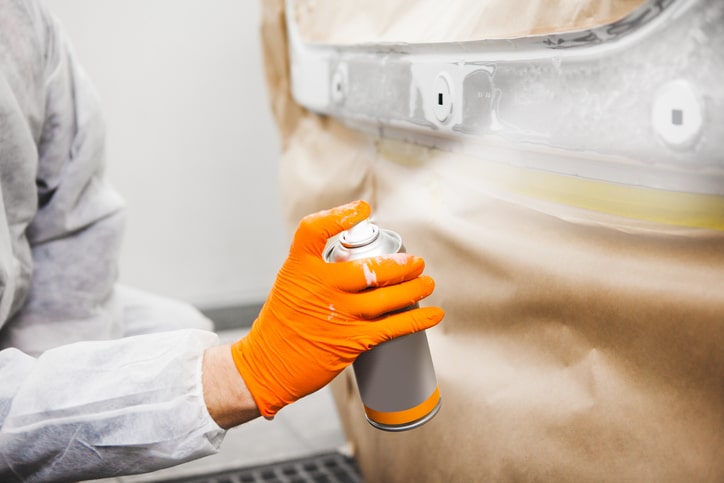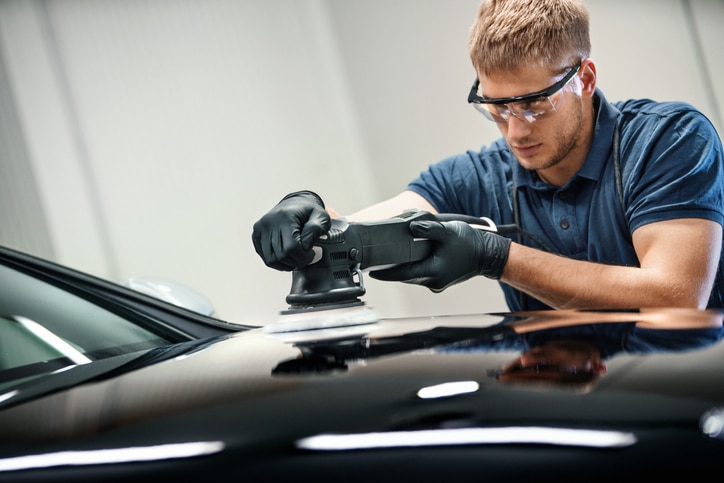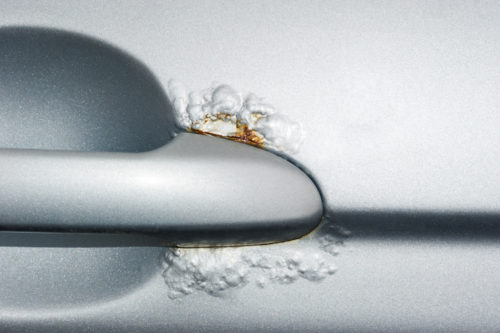Peeling, flaky paintwork occurs when one of the three layers coating the car’s bodywork (that’s primer, paint and clear coat) is damaged, often by a minor scratch or chip. If left untreated peeling paint will spread, leaving the bare metal bodywork exposed to moisture, oxidisation and everyday wear and tear — so it’s important to deal with it as quickly as possible.

Sometimes it can be hard to spot the early signs of peeling or flaking paintwork. But given the potential issues that can arise from leaving damaged paintwork untreated, it’s vital that you diagnose and fix imperfections before they get worse.
Here, we’ll show you how to spot and deal with peeling and flaking paint, with a range of tips on how to solve the problem, while ensuring the best results, below.
Quick Links
- How to Tell if Your Car’s Paintwork is Peeling or Flaking
- How to Remove Peeling and Flaking Car Paint
- Priming the Surface Ready for New Paint
- How to Apply the Paint and Clear Coat
- Why Does Car Paint Peel and Flake?
How to Tell if Your Car’s Paintwork is Peeling or Flaking
The first signs of peeling and flaking paintwork are likely to be small, hair-line cracks in the paint’s surface. These usually occur near a point of damage like a scratch, dint or stone chip.
Gradually, these cracks may develop into a unique pattern, almost like a tortoiseshell. The paint may also begin curling, revealing the bare metal beneath.
Because it’s sometimes hard to determine the extent of the problem, examine the whole area carefully so as not to miss any patches which could get worse down the line. Often what appears to be a small area of flakiness can reveal more when you closely inspect the paintwork.
It’s important to remove all of this flaky paint, as it’s impossible to restore it to its original condition without getting rid of every bit. Examine the surface carefully around any damaged areas, and make sure you’ve identified the exact spot where the flaking comes to an end before you begin any remedial treatment.
Once you’ve identified the areas affected by peeling paint, give the car a thorough wash to remove any trace of dirt, debris and grime. This will make it much easier to see how extensive the problem is, as well as any spots of rust or corrosion which may require more specialised treatment.
How to Remove Peeling and Flaking Car Paint
To guarantee complete protection against future peeling, you need to remove each coat down to the primer layer. This is best done with 1200-grit sandpaper.
Remove the paint from an area of 5 to 10 centimetres around the damaged area as well. Even if you can’t see any peeling here getting rid of this paint will help to prevent future damage.
The bare metal should be smooth and paint free, ready to be restored by a new coat of primer, paint and clear coat.

Priming the Surface Ready for New Paint
When you’ve removed all of the flaking paint, including the area around the main damage site, you’re then ready to prime the surface ready for a fresh coat of paint. This requires careful preparation to achieve maximum results and avoid similar damage in the future, so be sure to take care.
If you spray paint directly on to metal, you’ll experience some problems. The paint will struggle to stick to the surface, and the metal won’t be protected, which makes it more vulnerable to rust and other problems.
Using a primer before you paint prevents this, as it adheres to the surface and creates a smooth, protective layer for you to paint on. If you use a high build primer this will help to smooth any imperfections on the metal surface for a better finish. You can get high-quality primers which are specifically intended for use on cars.
Make sure the area is clean and dry before you start – it usually takes a couple of coats of primer to completely cover the metal surface. You’ll be able to see any imperfections or rough spots once the primer has dried. If you do notice anything you can sand it again and then apply some more primer. It’s important to take your time and get the surface as smooth as possible at this stage so you can achieve best results later on.
How to Apply the Paint and Clear Coat
The next step is to repaint the affected area. You’ll want the paint to match exactly, so use Paint Match Pro to find your paint.
You can search by car manufacturer, colour and year, or if you know your colour code you can search for that and find the right paint. You can also find a stockist near you who will sell the paint; these stockists will also be on hand with any advice on primers and general techniques.
For the best results, apply 2-3 coats of paint to the primer, followed by the same number of layers of clear coat. When applying both of these paints do so in thin, even coats, leaving between 10 and 30 minutes after each application.
This will help you to achieve a professional, flawless finish without breaking the bank. Leave the new paintwork for a few days and then wash it and wax is as normal to keep it protected and shiny.
Why Does Car Paint Peel and Flake?
Car paintwork is tough, durable and hardwearing. That’s because it’s made up of three layers, including the paint, primer and clearcoat, which work together to protect the metal and prevent corrosion.
When one of these three layers is compromised, however, it can kick-start a process called ‘delamination’. This is when one of the layers loses adhesion and begins to peel or flake away from the surface, a process that, if left untreated, can lead to the metal bodywork becoming exposed.
The main cause of peeling and flaking is external damage to the paintwork, either from a scratch, a dint or a chip. When one or all of the layers becomes damaged in this way, it essentially allows moisture and contaminants to infiltrate the paintwork, compromising the protection it offers to the bare metal underneath.
It’s crucial that you deal with flaking or peeling paintwork sooner rather than later. If left untreated, it can lead to the corrosion of the bodywork itself, which will be much more expensive and time consuming to put right.
At Holts, we’re committed to solving your car problems. To find out more, and view our complete product range, visit the homepage.


